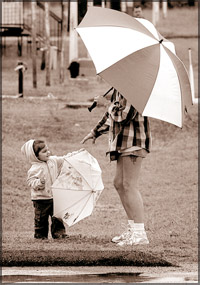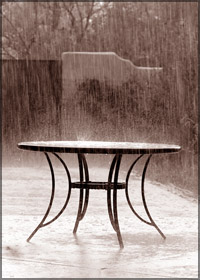|

Be alert to monsoon diseases
by Dr. K. Sreekanthan
 Monsoon brings with it the much awaited relief from the long spell of
sultry, scorching summer. However the cooling showers bring with them an
increased susceptibility to a lot of diseases that are peculiar to the
monsoon. It is time we get our safeguards ready and gear ourselves up to
face monsoon in its full glory. Monsoon brings with it the much awaited relief from the long spell of
sultry, scorching summer. However the cooling showers bring with them an
increased susceptibility to a lot of diseases that are peculiar to the
monsoon. It is time we get our safeguards ready and gear ourselves up to
face monsoon in its full glory.
In Kerala the south- west monsoon known as "Edavappathy/Kalavarsham"
usually begins in the first week of June. But it can be late or
sometimes earlier.
This year the monsoon has already begun as a continuation of the
summer rainfall. Along with the rainfall there is a sudden increase in
the occurrence of viral influenza disease with fever, cold and cough.
Last year there was an upsurge of Dengue fever.
Diseases that are spread during monsoon may be water borne, air-borne
or vector-borne.
These include the water-borne gastro intestinal infections like
Typhoid fever, acute diarrhoeal diseases like cholera and non-cholera
gastroenteritis, dysentery, jaundice due to hepatitis A and E, Air borne
diseases like influenza, mosquito borne disease like Dengue fever,
Malaria Japanese encephalitis. Other diseases are Leptospirosis (Weils
Disease*- Rat fever*), Conjunctivitis etc.
Contamination of water due to lower levels and unhygienic conditions
in cities are very often the cause of many monsoon ailments. Skin
conditions,Asthma and arthritis also aggravate because of excess
humidity.
 These and many other disease that are more commonly found in the
monsoon because the first few rain showers bring along with them
obnoxious gases,as well as the air-born germs ,thus accumulating in the
lakes and other areas , causing contamination of water. In severe
monsoon the drain pipes clog and overflow, sometimes mixing with the
water pipes and causing diseases. Even getting wet in the rains can give
rise to cold, coughs and fevers as well as body and joint pain. Sudden
change in temperature from extreme heat to cold can precipitate viral
infection. Collection of water in pot holes and stagnation of water as
breeding grounds for mosquitoes which spread diseases like Dengue fever
and malaria.The water get contaminated with rat urine containing the
microorganisms. These and many other disease that are more commonly found in the
monsoon because the first few rain showers bring along with them
obnoxious gases,as well as the air-born germs ,thus accumulating in the
lakes and other areas , causing contamination of water. In severe
monsoon the drain pipes clog and overflow, sometimes mixing with the
water pipes and causing diseases. Even getting wet in the rains can give
rise to cold, coughs and fevers as well as body and joint pain. Sudden
change in temperature from extreme heat to cold can precipitate viral
infection. Collection of water in pot holes and stagnation of water as
breeding grounds for mosquitoes which spread diseases like Dengue fever
and malaria.The water get contaminated with rat urine containing the
microorganisms.
Weeds enclosed ponds and water storages should be viewed only with
caution, as they become favourable dwellings for rats because of its
advantageous shelter providing characteristics. Sunlight is prevented
from passing down in total, thereby helping the disease germs to
flourish uninterruptedly from the sharp rays of the sun. In such
positive conditions the germs can sustain even for weeks.
The persons who come into physical contact with such water turn out
to be victims of disease like leptospirosis. The germs enter their
bodies even through minor cuts and wounds and mucous membranes of eyes
or oral cavity on immersion or taking bath.
Climatic variations are also yet another cause of disease spread. The
sudden onset of monsoon after recession of an extended hot summer
diminishes the normal health status of an average individual forcing him
prone to diseases. Especially people of extremes of age are more prone.
Patients suffering from chronic ailments like Diabetes mellitus, small
lung ailments or heart diseases, chronic rheumatism are more vulnerable.
Nevertheless, an important point to be mentioned here is that even in
spite of rainfall there is acute scarcity of good drinking water in many
parts of the state. This will lead to consumption of available source of
water which is not germ free. The following are a few safeguards that
one must follow in order to keep all diseases and infections at bay.
During monsoon intestinal functions along with the digestive system
become weak, and make the body highly susceptible to any kind of
infection.
Therefore always eat light food and avoid as far as possible too much
spicy and fried foods. In order to prevent water-borne diseases, do not
drink water which is not properly boiled and stored. Drinking water
should be boiled and properly filtered.
Avoid consuming food that is exposed to the surroundings for quite a
long time, since food that is exposed for along time are contaminated by
germs, which if enter the body, may cause various infections. Flies are
the most common carriers of germs that mostly cause contamination.
Therefore remember to cook the vegetables well and steam them
properly to kill the germ content in them, if any.Diabetic patients need
to take extra care of their feet during monsoon season.
These patients should take specific care as not to walk bare-foot
since the soil on which they walk is a reservoir of all types of germs.
Asthma patients also need to take special care during monsoon as they
should ensure that there is no accumulation and seepage of water from
the vicinity of their residence since that will cause severe health
problems. They should also ensure that fungus does not grow in the
wooden furniture, and in other articles like shoes and leather bags.
Prohibit mosquito - breeding since they are also carriers of deadly
germs. Do not let water accumulate in your surroundings.
Put a few drops of kerosene or Phenyl in the stagnant water to check
the undesired mosquito breeding. Mosquito net should be used wherever
possible.
Apart from naturally occurring diseases described above, electric
injury due to leakage of current, water dripping onto live electric
wiring, electrocution is also common.
It would be wise to give a thorough checkup to the wirings, switches,
plugs, and the positioning of the wires around the house. Furthermore do
not forget the electrical appliances. In case of any fault attend to
them at the earliest.
Also take care of your children who love to splash through water
logged streets, this could be dangerous. Water logging conceals a lot of
rubbish filling over from dustbins, drains and manholes.
It often contains glass pieces, stone chips slivers of wood and other
substances. These can inflict serious injuries on tender bare feet.
Thus a little effort on your part coupled with care and caution can
really help you enjoy this monsoon to its fullest. Be extra alert and
observe these safety guidelines.
Psychological disorders after a child birth
Dr. R.A.R. Perera
Consultant Clinical Psychologist.
Postnatal psychology deals with mental illness associated with
childbearing, and postnatal disorders. Postnatal disorders are divided
in to three groups - postnatal blues, puerperal psychosis and postnatal
depression.
 Post natal blues - In the first few days after childbirth, 60-70% of
women experience feelings of anxiety, lack of confidence, unpredictable
mood swings, with usefulness, difficulty concentrating and a general
feeling of confusion. The peak incidence is on the fourth or fifth day
and in general, these feelings last for 2-3 days. Although transient,
these symptoms cause distress to the mother who can be compounded by a
lack of understanding and support from those around her. Fortunately
there has been growing recognition of the problem, both by professionals
and by women and their families. A number of factors suggest there are
biological causes for this problem. These include the nature and timing
of the blues and an increased risk in women with a history of
premenstrual syndrome. Social class, chronic stresses and life events do
not seem to be related to the blues. The only social factors that may
have protective effects are supportive and social relationships,
primarily with the family and the spouse. There is no relationship with
a difficult delivery or being in hospital. Post natal blues - In the first few days after childbirth, 60-70% of
women experience feelings of anxiety, lack of confidence, unpredictable
mood swings, with usefulness, difficulty concentrating and a general
feeling of confusion. The peak incidence is on the fourth or fifth day
and in general, these feelings last for 2-3 days. Although transient,
these symptoms cause distress to the mother who can be compounded by a
lack of understanding and support from those around her. Fortunately
there has been growing recognition of the problem, both by professionals
and by women and their families. A number of factors suggest there are
biological causes for this problem. These include the nature and timing
of the blues and an increased risk in women with a history of
premenstrual syndrome. Social class, chronic stresses and life events do
not seem to be related to the blues. The only social factors that may
have protective effects are supportive and social relationships,
primarily with the family and the spouse. There is no relationship with
a difficult delivery or being in hospital.
Treatment:- Understanding and support from the professionals, family
and friends. Medication is not used in this common condition.
Puerperal psychosis:- The most severe but least common among
postnatal psychological disorders; it results in one admission in 500
births. It is an affective disorder similar to manic depressive
psychosis. There is pronounced disturbance of mood, which can be either
low or high or fluctuating between low and high. Delusions (false
beliefs) and or hallucinations (hearing or seeing things which are not
real) are also present. In depression, a woman may believe herself to be
bad or evil or hear voices telling her that terrible things are going to
happen to her or the baby or that she should harm herself. In mania, she
may believe that she has special powers. Associated symptoms include
sleep or appetite disturbances, impaired concentration, changes in
activity levels, impaired functioning or (as if people are plotting
against her) persecutory ideas.
Puerperal psychosis usually begins in the first week after delivery,
with the incidence dropping sharply over the next two weeks.
* Predisposing factors:-
A previous or family history of psychosis, first pregnancy, perinatal
death, alcohol and drug abuse, poor marital relationship and poor social
support. Most of these factors can be identified antenataly and used to
predict a high risk (50-60%) of psychosis, which can assist in planning
support services for the puerperium. The severity of the psychosis leads
to easy diagnosis and a Psychologist or a psychiatrist should
immediately see them.
Treatment:- Antipsychotic and depressant treatment. The risk of
relapse is about 50%, which can be puerperal (in another child birth),
non-puerperal or sometimes associated with menstrual periods.
Post natal depression
Postnatal depression is the most common major complication (physical
or psychological) of the postnatal (after a child birth) period. The
prevalence of major depression in the first 3 months postpartum is
10-15%; it peaks at about 4-6 weeks. The symptoms are - low mood, low
interest, hopelessness, impaired concentration, loss of appetite,
difficulty in sleeping, impaired functioning, sexual difficulties. She
is usually able to look after the basic physical needs of the baby. Many
of these features occur in the normal puerperium (after child birth) as
a result of the physical and psychological demands of having a new baby.
Postnatal depression is differentiated by the pattern of symptoms and
the severity. In addition to the mother's suffering, there is an impact
on the spouse, family and the development of the child. Social class,
parity nor adverse obstetric factors appear to influence the incidence
of postnatal depression. The two social factors that are consistently
associated with an increase risk are poor quality of marital
relationship and inadequate social support. Most cases of postnatal
depression go undetected and diagnostic tools have been developed to
assist diagnosis (Edinburgh postnatal depression scale).
General practitioners, health workers and midwives use it. In some
countries there are programs to screen all women at 6 weeks postpartum
(after a child birth).
Treatment:- Women with non-psychotic depression seldom requires
admission. Treatment is based on the same principles as depression
occurring at any other time, but consideration should be given to the
mother's situation. Less sedative antidepressants should be prescribed.
If the woman is breast-feeding, the choice of psychotropic medication is
restricted. Counselling is also important.
Hormones:- Up to 10% of cases of postnatal depression is associated
with postpartum autoimmune thyroid disease. Low progesterone levels also
can cause it.
Social support:- Encouraging women to develop and use supportive
networks are an important preventive and therapeutic measure. Selfhelp
organisations; health visitors and general practitioners can help.
The mother should be encouraged to develop her own source of support
rather than attempt provides direct support.
In Sri Lanka the parents of these new mothers and the midwives who
visit these new mothers generally manage these conditions. Adequate
training of these midwives and the primary care physicians (General
practitioners) is an important factor in reducing the social issues
associated in this important condition. |

